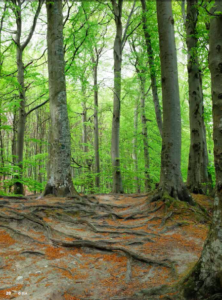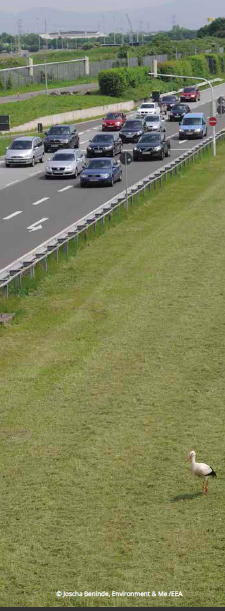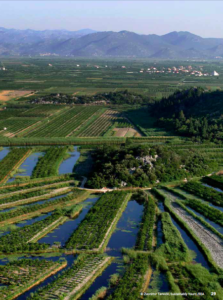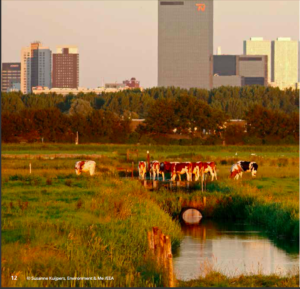The European Environment Agency has published another in its clear-headed and readable series, Signals. Previous issues addressed climate change (2015), transport (2016), energy (2017) and water (2018). The latest issue is titled, Land and soil in Europe: Why we need to use these vital and definite resources sustainably. The report reminds us that all our climate problems are not only above us in the atmosphere, but also under our feet on the land and its soil.
Europe is one of the most intensely used land masses in the world, with extensive landscape fragmentation from development, settlements and infrastructure, including highways and railways, much of this associated with urban sprawl. But other uses of the land from economic activities, especially agriculture, depend on and significantly impact our land and soil. Indeed, arable land and permanent crops, along with pastures and forests, cover about 76% of EU land surface.
What we eat requires fertile soils. Yet the soil is most fragile: one (1) centimeter (cm) of topsoil can take a few hundred to thousands of years to form. It is, in effect, a non-renewable resource. At the same time, the top 30cm of the world’s soil contains about twice as much carbon as found in the entire atmosphere. Soil is the second largest natural carbon sink after oceans. At 21-23.

In other words, we need to preserve and protect our land and soil. As just one example, the EU’s total CO2 emissions in 2017 were about 4.5 billion tonnes, yet 75 billion tones of organic carbon is stored in EU soil. If a significant portion of that were released into the atmosphere, our hopes of forestalling climate breakdown would be dashed. Either we adapt our use of land and soil to minimize or reduce climate breakdown, or our use-as-usual will accelerate that breakdown.
The Report offers an analysis of the pressures that exist on that land and soil, and how we need to relieve those pressures.
Urban expansion certainly affects land and soil use, and we expect about 75% of the world’s population will live in urban areas by 2050. As it is projected that an additional 30 million people will be added by 2050, that means that there will be 22 million more people joining our urban areas. It will require a lot of artificial surfaces to accommodate such a crowd, and we will have a Europe with more and more people living and relying on a smaller area.
At the same time as the population is growing and moving to urban areas, it is getting increasingly middle-class, with rising incomes that support more carbon-based activities, e.g., cars, bigger houses, air conditioners, and travel.
Much of this expansion and concentration results in sealing and compaction of soils. The sealing cuts off carbon and water inputs to the soil; compaction reduces pore space and degrades species living in the pores. Both are threats to our ecosystems, as well as to our food supplies.

The expansion of artificial surfaces covering the earth, by residential and commercial development and by infrastructure, also exacerbates the fragmentation of biodiversity, especially in urban areas. Habitats are carved into smaller and smaller patches, with fewer food resources and even a more limited gene pool.
The artificial surfaces also create runoff and prevent precipitation from seeping into soil, and replenishing it. The runoff also washes topsoil away and often into water bodies and, as we have noted, that topsoil does not regenerate quickly.
Climate breakdown exacerbates extreme weather events, which destroy land and soil, and which is making soil moisture in southern EU drier, and more barren, while soil in northern EU is getting wetter. The unfolding climate breakdown also threatens to melt the permafrost that has trapped massive amounts of CO2 and methane levels. If this organic material is released into the atmosphere it could be catastrophic.
The EEA report offers a series of ways to counter these pressures on the land and soil. Growing more plants and restoring degraded soils could remove more than 63 billion tonnes of carbon to offset GHGs. These new or restored soils would keep the carbon underground, and such natural and semi-natural areas would serve as effective defenses against climate impacts. Restoring peatlands and forests, with their substantial capacity to store carbon, is critical.

Instead of building new artificial surfaces, we can re-use and re-purpose existing urban areas for commercial or residential buildings, as in the Brownfield movement. Likewise, we can install green (natural systems and materials) instead of grey (concrete) infrastructure.
Finally, we need to recognize that designating land as private property may not serve the greater good, and that common and shared land may become increasingly necessary. While that sounds like a radical idea, in fact converting private property to public parks or public uses, through the legal means of eminent domain, is hardly revolutionary. And increasingly, communities are pressing for common ownership of forests and renewable energy sources, especially wind and solar.
Such notions are not that unfamiliar in Ireland where commonage, or joint ownership of large areas of grazing for sheep and cows, still exists.

One interesting implications of this EEA report is that agriculture cannot make claim to any special rights to the soil and land, as they are natural resources belonging to all citizens, with consequences for our rights to a carbon-free and methane-free world. To the extent that the agriculture sector demands more favorable treatment for its use of land, it has to account for competing uses of the land, e.g., wildlife corridors and forests.
Sources
European Environment Agency, Land and soil in Europe: Why we need to use these vital and definite resources sustainably (2019). bit.ly/30QODOu


No comments yet, add your own below